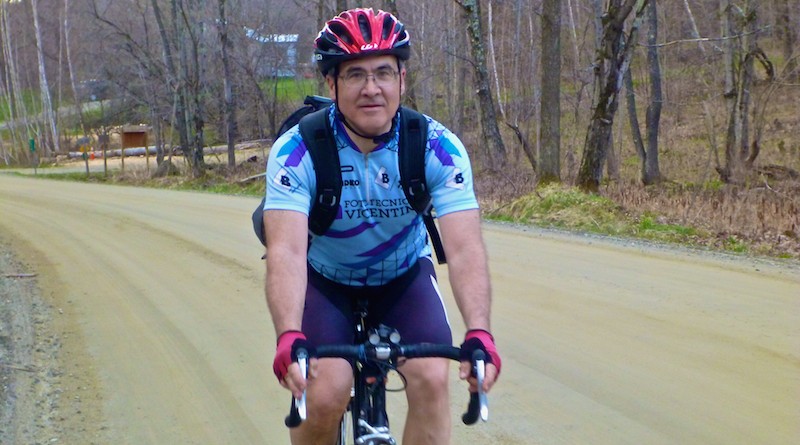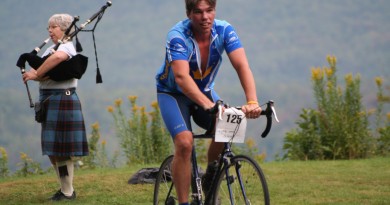Steve Barner: The Route Finder
In 1984 Steve Barner and his fellow bike mechanics at the Ski Rack in Burlington came up with the idea for the 100/200 ride. Billed as “one road, one state, one day,” the ride, which is entirely on Route 100, actually covers 212 miles with an elevation gain of roughly 15,000 feet. It has been named by Bicycling Magazine as one of the 10 toughest rides in the country.
Name: Steve Barner
Age: 60
Lives in: Bolton
Family: Wife, Jeanne
Occupation: Teacher
Primary sport: Cycling
VS: How did you come up with idea for the 100/200?
SB: It came up as part of a bigger initiative. Many years ago when John Wheeler owned the Ski Rack, he pointed out something that was an epiphany for me. We were having some issues with our employees badmouthing another local cycling shop which sold lower-end bikes. John said “They’re not our competition. Our competition is everything else that people could be doing besides riding bikes.” We realized that if people didn’t have a good experience cycling they wouldn’t want to bike; they’d go windsurfing instead or whatever was popular at the time. We had more in common with the folks at other bike shops than differences so we started a series of get-togethers to get to know one another. We started meeting roughly once a month and conceived of a number of events. In 1984 we decided to ride the length of the state on Route 100. The first year there were only six of us and we were all from the Ski Rack. After saying we’d never do it again, the next year we did it again and 30 people showed up.
VS: How big did it get?
SB: The most we ever had was 60 but that was really too big for us. Riders had their own support crews and at one point we tried to collect money from people to pool our resources but we realized that when you charge people, they expect services. Then in 1990, the weather was so bad we had to cancel the ride. After that we stopped having the ride for several years.
But year of my 50th birthday I started sending out invitations again. It quickly grew back to the size it had been before. We generally have 30 to 50 people.
VS: Did you ever not finish the ride?
SB: One year I bonked just outside Brattleboro and had run out of food, water and money. Jeanne, my support car, was 50 miles away. I got off the bike and laid down in the sun in a pullout by the side of the road. An SUV pulled over and a woman asked if I was okay and I said yes. She started driving and then stopped. Two little girls came running out and said “This is mommy’s sandwich. She thinks you need it more than she does.” That saved my bacon and I was able to finish the ride.
VS: You say that anyone can do the ride. Can you explain that?
SB: I hate the term “serious cyclist” but people who have been riding for a long time and have done a number of centuries can typically finish. We had a tiny woman with two kidney transplants who rode it twice. It’s all about pacing yourself. If you ride fast and aren’t in shape, you’ll blow up, but if you’re used to long miles, you can do it. There are people you look at and think they’ll never finish but they do and others who look like they’re in great shape but throw in the towel at Ludlow. Route 100 is an incredible road most of which is really nice for cycling. It’s hit and miss for the pavement but there isn’t that much traffic and there are all these strategically placed town greens. Doing it north to south there is a rhythm to it although it’s a bit like a hammer going down on you.
VS: You also commute by bike, from Bolton to Burlington, don’t you?
SB: It started because when I was a kid that’s how I got around. We were a one-car family. People thought differently back then. My first jobs were in bike shops and that’s how I got to work and those jobs didn’t pay enough to get a car. In my 30’s when I first began teaching, my biking dropped off dramatically but I never gave it up. As I got more comfortable with teaching I started realizing that my body type wants to be overweight and if I stop exercising, that’s what happens. It takes me half an hour to drive to work in South Burlington. On a good day, it’s a little under an hour to get in and an hour and ten minutes to get home by bike. In the winter, though, it can take me almost two hours to get home when it’s snowing and cold.
VS: But you still ride in the snow and the cold?
SB: Typically, I don’t like to go out when it’s less than ten degrees but I have. I have decent equipment but my feet will get so cold that they’ll be numb and painful as they thaw out. I have bad circulation so that’s the worst part. Those chemical heaters will get you a couple of miles but they don’t last for the entire ride. The biggest thing is loose fitting shoes and multiple layers. I won’t ride to work if it’s snowing and will take a day or so off after a snow storm because the snow at the edge of the road becomes almost impossible to ride through and isn’t safe.
VS: How did you become the Green Mountain Bicycle Club mapmaker?
SB: When I started riding with the club there was a real mismatch of maps being handed out. People would take their Gazetteers and make photocopies and then use magic markers to trace the route. There were some cue sheets that were written by hand. People were well-meaning but some of those maps were pretty illegible. I taught graphic design for decades so I volunteered to help. When there is a new route I go online and look at maps until I find a magnification level I can capture using Google Maps or another service. I think about how it will fit on a page and then do a series of screen shots and piece those together in Photoshop which becomes the base layer. Then I trace out the routes using different colors for the different route lengths and I might add arrows and features like stores or things to look for like covered bridges. Then I create a cue sheet with the distances for each road segment, the various turns and the distance to the finish. If there is room, I add the GMBC ride rules. I think it’s a great service because it’s on the website so people can check out the route including the distance and elevation gain before the start of the ride. We also have an online library with all our routes which is something I don’t see for other clubs.
VS: You don’t consider your cycling ability extraordinary but I’m sure others do.
SB: I really don’t. I consider myself unusual only because other people are unenlightened. The bicycle should be much more part of our life as a culture and it’s not. I think that’s a bad thing. I think the bicycle can solve a lot more of life’s problems. It requires us to take action which is good. When we get off our butts and start doing things we get healthier and friendlier and it’s all good. Cars are great things but we don’t limit our use of them as much as we should.


